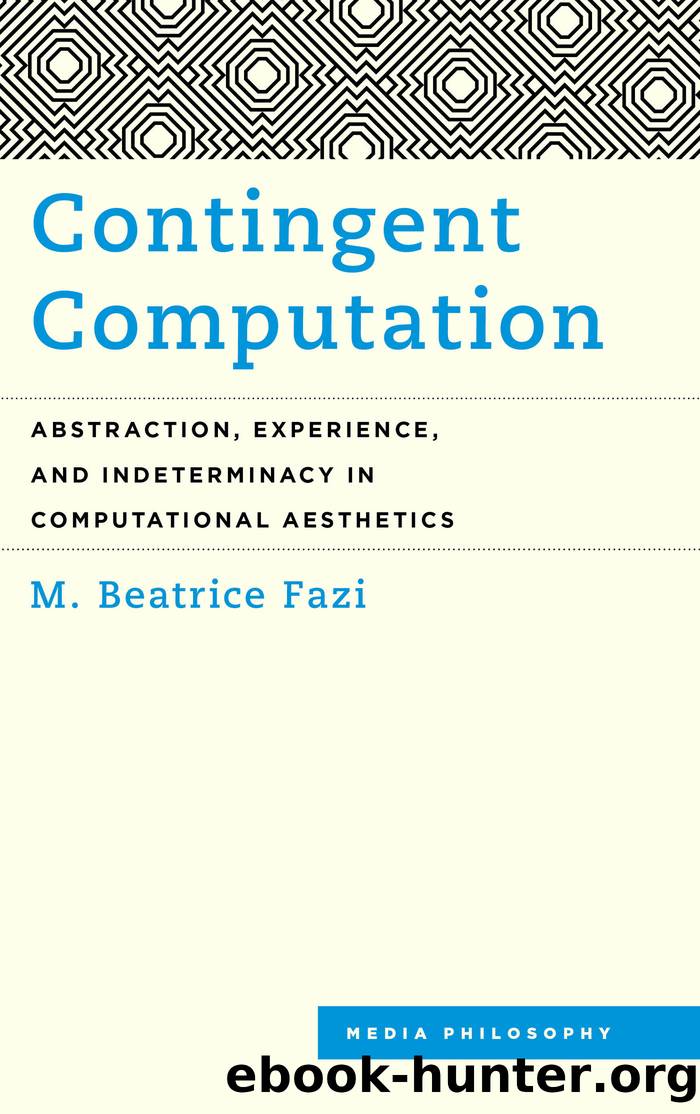Contingent Computation by Fazi M. Beatrice

Author:Fazi, M. Beatrice
Language: eng
Format: epub
Tags: undefined
Publisher: Book Network Int'l Limited trading as NBN International (NBNi)
Published: 2012-08-15T00:00:00+00:00
The Discretisation of Infinity
From a mathematical point of view, Turingâs 1936 work was intended to engage with the existence of numbers that cannot be computed. This was (and still is) an actual problem in mathematics, confronting one of the most uncomfortable yet exciting concepts of the discipline: infinity. At the core of Turingâs investigation on computability there is a transversally posed but crucially metaphysical problem: how is it possible to define the infinite in finite terms? The infinity in question is that of real numbers: a class of values representing quantities along a continuum, like points in a line, whose digits are infinite and thus uncountable. The finite steps, conversely, are those of the deterministic method used by Turing to cope with the dilemma itself. Turing divided the machineâs functionality into small operations, whose complete purpose and conclusion were ruled by their own configuration and whose actions were set out by an equally finite table of behaviour. A Turing machine program is itself a description of an effective method of calculability, facing the possibility of encountering real numbers that cannot be computed with any desired certainty via an enumerable (and hence countable) set of instructions. The impossibility of processing the vast majority of real numbers through a mechanical procedure couples infinity and decidability in a binding logical argument: it is impossible for any Turing machine to prove if any other similar device would be able to write (which means, to calculate) the infinite digits of a real number on its blank tape.
At first, this conclusion would only seem to be relevant within the lecture hall of a mathematics department or at the repair bench of the local computer shop. However, incomputability haunts economists as much as it does biologists, physicists, and pretty much anybody who has ever switched on a computing device. It is because of incomputability that, to this day, there does not exist a 100 percent bug-free computer program. The correctness of a piece of software cannot be finally determined because of the inherent limits of algorithmic methods of testing, which check a computer program by executing the tested code in a finite-step, line-by-line manner. The infinite possibilities of endless loops in a program are beyond the finiteness of the time-constrained procedure constructed to infer its fallaciousness. We just do not know until we execute or run the program itself. We just do not know, for instance, if a program will halt until we run that program, and we cannot tell which inputs will lead to an output. This condition can also be said to pertain to the reasons for the contemporary software industryâs tendency to neglect its capacity for generalisation in favour of more specific, limited solutions that are viable only within certain contexts and parameters. In concrete terms, rather than engaging in creating software that provides a universal answer for a certain requirement, the industry finds it more relevant to provide the market with very specific products, whose finite algorithmic determinacy is thus easier to be tested or proven.
Download
This site does not store any files on its server. We only index and link to content provided by other sites. Please contact the content providers to delete copyright contents if any and email us, we'll remove relevant links or contents immediately.
Algorithms of the Intelligent Web by Haralambos Marmanis;Dmitry Babenko(9832)
Azure Data and AI Architect Handbook by Olivier Mertens & Breght Van Baelen(7609)
Building Statistical Models in Python by Huy Hoang Nguyen & Paul N Adams & Stuart J Miller(7593)
Serverless Machine Learning with Amazon Redshift ML by Debu Panda & Phil Bates & Bhanu Pittampally & Sumeet Joshi(7478)
Data Wrangling on AWS by Navnit Shukla | Sankar M | Sam Palani(7236)
Driving Data Quality with Data Contracts by Andrew Jones(7232)
Machine Learning Model Serving Patterns and Best Practices by Md Johirul Islam(6962)
Learning SQL by Alan Beaulieu(6210)
Weapons of Math Destruction by Cathy O'Neil(6143)
Big Data Analysis with Python by Ivan Marin(5883)
Data Engineering with dbt by Roberto Zagni(4899)
Solidity Programming Essentials by Ritesh Modi(4528)
Time Series Analysis with Python Cookbook by Tarek A. Atwan(4358)
Pandas Cookbook by Theodore Petrou(4057)
Blockchain Basics by Daniel Drescher(3507)
Natural Language Processing with Java Cookbook by Richard M. Reese(3099)
Hands-On Machine Learning for Algorithmic Trading by Stefan Jansen(3027)
Feature Store for Machine Learning by Jayanth Kumar M J(2908)
Learn T-SQL Querying by Pam Lahoud & Pedro Lopes(2878)
